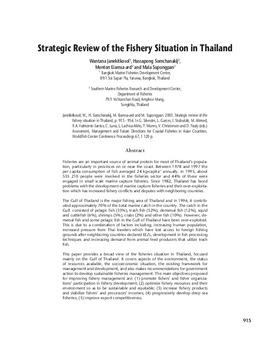Strategic review of the fishery situation in Thailand

Citation
Wantana Janekitkosol et al. (2003). Strategic review of the fishery situation in Thailand. p.915-955. Assessment, management and future directions for coastal fisheries in Asian countries. WorldFish Center conference proceedings; 67
Fisheries are an important source of animal protein for most of Thailand’s population, particularly in provinces on or near the coast. Between 1978 and 1997 the per capita consumption of fish averaged 24 kg·capita-1 annually. In 1995, about 535 210 people were involved in the fisheries sector and 44% of these were engaged in small scale marine capture fisheries. Since 1982, Thailand has faced problems with the development of marine capture fisheries and their over-exploitation which has increased fishery conflicts and disputes with neighboring countries. The Gulf of Thailand is the major fishing area of Thailand and in 1996, it contributed approximately 70% of the total marine catch in the country. The catch in the Gulf consisted of pelagic fish (33%), trash fish (32%), demersal fish (12%), squid and cuttlefish (6%), shrimps (5%), crabs (2%) and other fish (10%). However, demersal fish and some pelagic fish in the Gulf of Thailand have been over-exploited. This is due to a combination of factors including; increasing human population, increased pressure from Thai trawlers which have lost access to foreign fishing grounds after neighboring countries declared EEZs, development in fish processing techniques and increasing demand from animal feed producers that utilize trash fish. This paper provides a broad view of the fisheries situation in Thailand, focused mainly on the Gulf of Thailand. It covers aspects of the environment, the status of resources available, the socioeconomic situation, the existing framework for management and development, and also makes recommendations for government action to develop sustainable fisheries management. The main objectives proposed for improving fishery management are: (1) promote fishers’ and fisher organizations’ participation in fishery development; (2) optimize fishery resources and their environment so as to be sustainable and equitable; (3) increase fishery products and stabilize fishers’ and processors’ incomes; (4) progressively develop deep sea fisheries; (5) improve export competitiveness.
Permalink
Date Available
Type
Publisher
Countries
Copyright
CC BY 4.0
Research Themes
Topics
Language